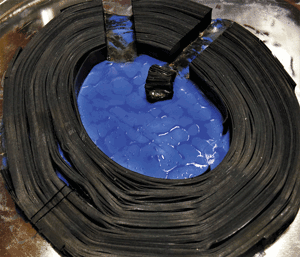Historical films may be decaying much faster than we thought thanks to 'vinegar syndrome'

A significant chunk of the world’s history is facing an existential threat. US government deeds, recordings of Indigenous Australians and photographs of English seaside life spanning three decades are just some of the historical documents recorded on acetate film that are suffering irreversible damage due to what’s known as vinegar syndrome. (Pictured: Cellulose triacetate 16 mm film with severe vinegar syndrome, dated 1968.)
Vinegar syndrome happens when acetate film is stored in a warm, humid room. These conditions cause the film to decompose. As the film starts to rot, it gives off acetic acid, the same ingredient in household vinegar that gives its distinctive smell and taste. The acid speeds up degradation in the affected film, and can even damage metal storage containers and other films stored nearby.
Vinegar syndrome cannot be prevented forever, nor can it be reversed. It can only be delayed. This is why archives store their film collections in a cold and dry environment. Film stored in these conditions was expected to last for hundreds of years before vinegar syndrome started to set in. But my colleagues and I have recently shown that these forecasts are overconfident, and that countless acetate films are facing imminent destruction.
Current guidelines suggest that film stored in the same conditions could last about 450 years. For films made in 1950, when acetate films were becoming popular, this implies that vinegar syndrome won’t develop until about the year 2400.
But our research predicts that films stored in recommended conditions may last as little as 70 years before developing vinegar syndrome. According to our model, a film produced in 1950 and stored in the recommended conditions since then could develop vinegar syndrome this year.
Modelling film degradation
To understand how film might degrade over long periods of time, scientists perform experiments on film at high temperatures and relative humidity. These are called accelerated or artificial ageing experiments. The scientists take measurements of a feature that is considered a relevant indicator of degradation in the film.
A common measurement is free acidity, which is different from pH. This gives a more sensitive measure of the amount of acetic acid that has built up in the film. Vinegar syndrome is considered to start when the free acidity reaches a level of 0.5.
Measuring the free acidity over time, the artificial ageing experiments build a picture of how long it takes for film to develop vinegar syndrome in hot, humid conditions. Scientists can use the results of these experiments to estimate how milder conditions that are more similar to the environment found in archives will affect the film.
As noted, the acid speeds up degradation in the film, including the chemical reaction that produces the acid in the first place. If film is stored in a closed container that prevents acid from escaping (often the case with film frequently stored in metal or plastic cans), this can result in an exponential rise in acid levels over time.
In the early stages of degradation, acid levels are low and this trend is not apparent. This has meant that, in previous studies, researchers assumed that during the early stages of a film’s lifetime, acidity levels were too low to affect film degradation. Earlier models therefore did not account for the effect of acid on the degradation rate from the beginning.

A more recent study from the British Library challenged the assumption that acid does not influence film degradation from the beginning. It found no evidence to support that the chemical mechanism changes when the acidity reaches a level of 0.5.
Our study proposed a model to account for the effect of acid during the whole of the degradation process, including the early stages. We used data from two studies from the Image Permanence Institute in the US to develop and validate the model. We then used the model to make forecasts about film stability under typical archive conditions. These forecasts were compared with commonly used guidelines in film preservation.
Acetate films were widely adopted from the 1950s to 1980s, so it is likely that a large proportion of photographic records from this period are at risk. For example, the BFI Master Collection consists of over 450,000 cans of film, of which 59% are acetate films. One of the biggest dangers of film exhibiting vinegar syndrome is that if not properly stored, the acid fumes may spread to other films. Just one reel of severely degrading acetate film could cause serious damage to the rest of the collection if the vinegar syndrome is not contained.
There are three basic strategies for dealing with vinegar syndrome:
-
Improve storage conditions by reducing moisture and lowering the temperature.
-
Quarantine any films identified as having vinegar syndrome to prevent the spread.
-
Duplicate the film or convert it to a digital medium.
The damage done by vinegar syndrome is irreversible, and will eventually make the film unsalvageable, so it is best to follow the above tips. Researchers at Queen Mary University of London were recently able to recover images from an afflicted film reel, which was too brittle and fused together to be unwound, using an X-ray scanning technique. However, this method would not be possible at scale.
Archives use guidelines to plan their film preservation strategy. For large collections, storing film in cold vaults is much cheaper than copying. If cold storage really could delay vinegar syndrome until 2400, then copying is not urgent. However, the new model predicts that vinegar syndrome will happen much sooner. We may only have a few more years, not a few centuries, to act before these films are lost forever.
![]()
Ida R. Ahmad is a PhD Candidate, Institute of Sustainable Heritage, UCL
This article is republished from The Conversation under a Creative Commons license. Read the original article.
